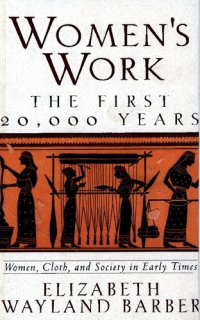
Ebook: Women's Work : The First 20,000 Years : Women, Cloth, and Society in Early Times
Author: Elizabeth Wayland Barber
2,500 years ago, the women of Athens worked at home, virtual prisoners of their husbands, expected to provide cloth and clothing for the family. 4,000 years ago in ancient Mesopotamia, there was a very different picture: respectable women were in business for themselves, weaving textiles at home to be sold abroad for gold and silver. Looking back even further to 20,000 years ago, women began making and wearing the first clothing created from spun fibers: string skirts that announced to all a woman's ability to bear children. Indeed, for over 20,000 years, until the Industrial Revolution, the fiber arts were an enormous economic force, belonging primarily to women. Throughout early history, this art was the primary vehicle for articulating a woman's various roles as mother, provider, worker, entrepreneur, and artist, and was a vital force for self-definition, early steps to creative expression.
Modern women searching for their roots will not find this part of themselves in most history and archaeology books. Much of this gap of information results from the extreme perishability of what women generally produced — food and clothing. These objects do not survive the wear of time as well as houses, tombs, temples, stone sculpture, and the other usual artifacts of archaeology. Thus, in most books on ancient history and economics there isn't even an index entry for cloth or clothing, despite the enormous toil required in making them. Well may women object: economic studies that omit half the economy—which happens to be the female-produced half—are skewed.
Fortunately, archaeological methods of recovering information have been improving rapidly, and we may get the full story not only of our economic development but of the evolution of women's art and place in society. Author Elizabeth Wayland Barber has drawn from data gathered by the most sophisticated new methods for studying the past, methods she herself helped to fashion, shaping a wealth of new information on one of women's most important contributions to past societies—textiles. Her widely acclaimed, monumental study of the technical development of the craft appeared recently in her book Prehistoric Textiles. In this work, the author presents the untold human side of that story: the relations of women and their textile work to society and economics over the huge span of prehistoric and early historic times. We see women at their work in prehistory and ancient Greece and are provided an unprecedented and intimate look at their daily life. We learn of the growth of the textile industry, of fashion and ancient costume. And we reclaim an essential part of human history forged by women.
Elizabeth Wayland Barber teaches linguistics and archaeology at Occidental College in California and holds a Ph.D. from Yale University. She has received eight grants to forward her work.